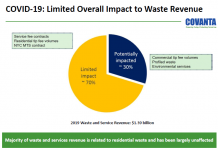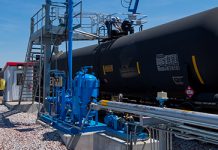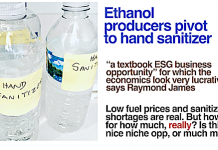Jim Lane
The second technology focused on unlocking value in municipal solid waste comes to the public markets.
Here’s our 10-minute version of the filing, with a translation of the risks into English.
In Canada, Enerkem has filed an F-1 registration statement for a proposed $125 million initial public offering. The number of shares to be offered in the proposed offering and the price range for the offering have not yet been determined. The lead book-running managers for the offering are Goldman Sachs, Credit Suisse and BMO Capital Markets.
The company is currently ranked #7 in the world in the 50 Hottest Companies in Bioenergy. The rankings recognize innovation and achievement in fuels and are based on votes from a panel of invited international selectors, and votes from Digest subscribers.
Enerkem, which in the first three quarters of 2011 lost $19.1 million while recording $887K in revenues (primarily government grants) becomes the 15th company to file for an IPO in the industrial biotech boom, which began with a successful listing on the NASDAQ by Codexis (CDXS) in 2010. IPOs by Amyris (AMRS), Gevo (GEVO), Solazyme (SZYM), and KiOR (KIOR) have followed. In recent months, Coskata, PetroAlgae (PALG.PK), Bioamber, Myriant, Ceres, Genomatica, Mascoma and Elevance Renewable Sciences and Fulcrum Bioenergy have also filed S-1 registrations for proposed IPOs.
Here’s the F-1 registration, in a conveniently downsized 10-minute Digest version – with some commentary along the way as to what is driving value in the Enerkem model, opportunities for the intrepid investor, and some risks which we have translated from the ancient and original SEC into modern English.
Company Overview
From the F-1: “We develop renewable biofuels and chemicals from waste using our proprietary thermochemical technology platform.
We intend to take advantage of the abundant supply of municipal solid waste, or MSW, which we expect to be paid to use as feedstock, to profitably produce cellulosic ethanol, a second-generation biofuel. We believe that our waste-based biofuels provide one of the most advanced solutions to the growing world demand for renewable sources of energy, while also addressing the challenges associated with waste disposal and greenhouse gas, or GHG, emissions.
Our pilot facility in Sherbrooke, Canada has been in operation since 2003 and has a throughput capacity of 4.8 metric tons per day. We have successfully increased, or scaled-up, our throughput capacity tenfold, or 10x, to 48 metric tons per day in our commercial demonstration facility in Westbury, Canada. The Westbury facility has a production capacity of 1.3 million gallons per year, or MMGPY.
Our first standard 10MMGPY commercial facility is currently under construction in Edmonton, Canada. We have developed a modular, copy-exact and scalable approach for equipment production and installation that we anticipate will allow us to have our systems manufactured by third parties as pre-fabricated, replicable modules under fixed-price contracts.
The Technology
From the F-1: “Our proprietary technology platform converts MSW and other heterogeneous waste feedstocks, consisting of mixed textiles, plastics, fibers, wood and various other forms of waste, into a pure, chemical-grade synthesis gas, or syngas. This syngas is then converted into biofuels and chemicals through well-established catalytic reactions.
Feedstock preparation. The MSW we plan to use as feedstock is first sorted, using equipment and processes used in existing sorting and recycling facilities in order to remove unusable materials. During this process, typically approximately 40% of the MSW is removed from the waste stream and approximately 60% of the MSW is shredded to be used as feedstock.
Gasification through a bubbling fluidized bed. Our proprietary bubbling fluidized bed gasification reactor breaks down the feedstock into its constituent parts or molecules, a process that is called thermal cracking. In the same reactor, these broken-down molecules are then blended with steam to produce syngas.
Syngas cleaning and conditioning. Our bubbling fluidized bed gasification process yields a crude syngas that is fed into our proprietary syngas cleaning and conditioning process. This process upgrades the crude syngas to a chemical-grade syngas that can be refined into liquid fuels and chemicals.
Catalytic conversion into final products. We typically start by reacting a portion of our syngas with a commercially available catalyst to produce methanol, which we can either sell as an end-product or use as an intermediate to make other products. To produce ethanol, we react methanol with carbon monoxide from our syngas with a commercially available catalyst to produce methyl acetate. The final conversion step in our ethanol production process entails splitting the methyl acetate by inserting a hydrogen molecule that is extracted from the produced syngas.”
The Market
MSW Market. The United States generated 435 million metric tons of MSW in 2009, of which approximately 289 million metric tons, or 66% was landfilled. The company projects that approximately 140 million metric tons is suitable for ethanol production through gasification, yielding up to 14 billion gallons of ethanol annually.
The remaining landfill capacity for MSW in the United States as of 2009 equates to approximately 19 years of remaining life at 2009 MSW disposal rates, down from 26 years in 1995. 30% of Canadian landfills reported having an expected remaining life of fewer than ten years.
Tipping fees. According to the Waste Business Journal, an industry publication, average tipping fees for landfills in the United States were $47 per metric ton in 2009. The company projects that every $10.00 dollars per metric ton of tipping fees that they receive will generate revenue of approximately $0.12 per gallon.
Global fuels market. According to the Energy Information Administration, or EIA, global crude oil and liquid fuel consumption of approximately 87 million barrels per day, or bbl/day, equates to approximately a $2.5 trillion market in 2010, at an average price of approximately $79 per barrel.
US Renewable Fuels Market. The U.S. Renewable Fuel Standard mandates 16 billion gallons per year of cellulosic biofuels, which include cellulosic ethanol, be blended by 2022. The company projects cellulosic ethanol
in the United States at operating costs, before depreciation and amortization, of $1.50 to $1.70 per gallon in a 10MMGPY facility. They estimate that they can reduce costs to approximately $1.05 to $1.25 per gallon by building 40MMGPY facilities (four of our 10Mgy units).
Price floor. In the US, the EPA creates cellulosic biofuel waiver credits, or CWCs, for purchase for that year. The CWCs to be made available for sale to obligated parties in 2012 for the higher of (1) the amount by which $3.22 per gallon (in 2011 prices) exceeds the average wholesale price of a gallon of gasoline in the United States or (2) $0.27 per gallon (in 2011 prices).
Chemicals. Methanol can act as a building block for acrylic acid, with a market size of $3.1 billion in North America and $10.9 billion globally; n-Propanol, with a market size of approximately $1.5 billion in North America and $3.0 billion globally; and n-Butanol, with a market size of approximately $2.4 billion in North America and $7.5 billion globally.
The Risks, Translated from SEC-speak
Among the lowlights of reading S-1 registrations are the endless pages of risk disclosures couched in an alloy of SECspeak and legalese.
We offer these excerpts from the original S-1, and a translation into English, prepared by our Digest lexicologists.
In SECSpeak: We have not yet completed the manufacturing of our first standard 10MMGPY prefabricated module and design defects may occur in our equipment and/or modules, which may adversely affect our business and financial results.
In English: Oy vey, build-out, schmild-out, vat could be de problem?
In SECSpeak: Our, or any of our partners’, inability to obtain an adequate supply of MSW may adversely affect our business and financial results.
In English: “Waste is a Terrible Thing to Mind.”
In SECSpeak: Changes in government regulations, including mandates, tax credits, subsidies and other incentives, could have a material adverse effect on our business and results of operations.
In English: G-Man, give me some lovin’.
In SECSpeak: Infrastructure constraints pose uncertain market barriers for ethanol.
In English: “Alex, I’ll take ‘Blend Wall’ for five hundred, please.”
In SECSpeak: We may need substantial additional capital in the future in order to expand our business.
In English: That giant sucking sound you hear: that’s our CAPEX fund.
In SECSpeak: We have not produced ethanol at a scale needed for the development of our business or built the facilities needed for such production. Furthermore, the conversion of methanol into ethanol in large commercial volumes may prove to be more challenging than we anticipate and may not initially be possible in a cost-effective manner.
In English: Psst! The secret phrase is “Range Fuels.”
In SECSpeak: Our partners may not adequately operate the systems utilizing our proprietary technology platform or safeguard our intellectual property and confidential information, which may adversely affect our business.
In English: Dang it Zeke, how do you work this darn thing anyway? Is this right? Oops. Eew, that’s not right.
In SECSpeak: Our ability to compete may decline if we are required to enforce or defend our intellectual property rights through costly litigation or administrative proceedings.
In English: Psst! The secret phrase is “Butamax and Gevo.”
In SECSpeak: We rely in part on trade secrets to protect our technology, and our failure to obtain or maintain trade secret protection could adversely affect our competitive business position.
In English: Psst! The secret phrase is “INEOS Bio and Coskata.”
The Strategy
From the F-1: “1. Build, own and operate new facilities.
2. Pursue development opportunities with select industry-leading companies.
3. Focus on reducing our costs.
4. Expand internationally.
5. Innovate and develop new products.”
The Commercialization Plan
From the F-1: 1. Westbury, Canada demonstration, 2009-2011.
We completed the installation of methanol production equipment in Westbury in 2011, and the facility commenced production of methanol in June 2011. We intend to add ethanol production equipment to the Westbury facility in 2012 to enable a production capacity of 1.3MMGPY.
2. Edmonton, Canada first commercial plant.
In 2010, we commenced construction of our first standard 10MMGPY commercial facility in Edmonton. We intend to build, own and operate this facility, which is located on a municipal landfill to provide us proximity to feedstock. We have secured a 25 year MSW feedstock supply agreement with the City of Edmonton. We expect to ready our Edmonton facility for methanol production in the first quarter of 2013.
3. Pontotoc, Mississippi second commercial plant.
We plan to commence construction of an additional 10MMGPY commercial facility in Pontotoc in the fourth quarter of 2012. The Pontotoc facility will be located on a landfill site and will be constructed by our wholly-owned subsidiary Enerkem Mississippi Biofuels LLC. We estimate that it will take approximately 18 months to build the facility.
In December 2009, we were awarded U.S. Department of Energy, or DOE, conditional financial assistance of $50.0 million under the American Recovery and Reinvestment Act of 2009 Demonstration of Integrated Biorefinery Operations Program, for the development of the Pontotoc facility.
4. Varennes, Canada third commercial plant.
We also plan to commence construction of a 10MMGPY commercial facility in Varennes as early as the first quarter of 2013. We estimate that it will take approximately 18 months after commencement of construction to build the facility. This facility will be constructed by Varennes Cellulosic Ethanol L.P., a 50/50 joint venture with GreenField Ethanol Inc., one of the largest ethanol producers in Canada. The Varennes facility will be located on the site of GreenField’s grain ethanol facility in Varennes.
5. Waste Management and Valero
Our term sheet with an affiliate of Waste Management (WM) contemplates the sale of systems utilizing our proprietary technology platform for the potential development of up to six sites with a combined ethanol production capacity of 100-120MMGPY. With Valero, we have entered into a non-binding term sheet to sell our systems for the development of up to six stand-alone facilities with a combined ethanol production capacity of 80-250MMGPY and additional facilities to be co-located with existing Valero facilities. We expect that our arrangements with Waste Management and Valero would also provide us with an option to own up to 49.5% or 50.0% of these facilities, respectively.
6. Other Projects and Considerations
We have prioritized, based on specific selection criteria, 68 landfills in the United States as potential sites for development by us or our strategic partners. These locations represent a combined waste inflow of 40 million metric tons of unsorted MSW, which represents a potential produ
ction of 2 billion gallons of ethanol per year using approximately 200 of our standard 10MMGPY modules.
Enerkem as it sees itself: 6 Competitive Strengths
From the F-1: “Converting heterogeneous waste to biofuels and chemicals. We believe that we are the first company to produce a pure, chemical-grade syngas using heterogeneous waste in a commercial demonstration facility. Since 2003, we have tested and validated our technology with MSW from numerous municipalities, as well as a broad variety of other feedstock, at both our pilot and demonstration facilities.
Lowest scale-up among cellulosic ethanol producers. The scale-up from our commercial demonstration facility in Westbury to our planned standard 10MMGPY commercial facilities represents approximately a 2x scale-up in gasification and gas conditioning equipment size and approximately a 7x scale-up in throughput capacity.
Large market opportunities and an attractive cost structure. Our primary product focus is cellulosic ethanol, a significant market opportunity that is driven by a rapidly growing market demand for renewable biofuels, and is further bolstered by government mandates and incentives. In addition, we believe our cost structure benefits from the ability to locate our compact facilities on or near landfill sites, the abundant supply of negative cost MSW feedstock and our competitive production costs.
Tangible commercial pipeline. In addition to our first standard 10MMGPY commercial facility under construction in Edmonton, we have two 10MMGPY commercial facilities under development in Pontotoc and Varennes. Beyond these projects, we have prioritized 68 landfills in the United States as additional potential sites for development by us or our strategic partners, representing a potential production of 2 billion gallons of ethanol per year using 200 of our standard 10MMGPY modules.
Key strategic relationships with industry-leading partners. We have entered into a non-binding arrangement with an affiliate of Waste Management (WM) to sell systems using our proprietary technology platform for the potential development of up to six sites with a combined ethanol production capacity of 100-120MMGPY.
With Valero, we have entered into a non-binding term sheet to sell systems using our proprietary technology platform for the development of up to six stand-alone sites with a combined ethanol production capacity of 80-250MMGPY and additional facilities to be co-located with existing Valero facilities.
Experienced management team. Our executives and senior managers have built our business from the ground up and have extensive experience in research and development, business development, project financing, procurement and plant operations.”
Financing to date
Enerkem has incurred substantial net losses to date, losing $C5.9 million in 2008, $C3.7M in 2009, $11.8M in 2010 and 19.1M for the first nine months of 2011.
From the F-1: “On March 13, 2009, in connection with a $4,000,000 loan from Atel Ventures, Inc., we issued a warrant to Atel Ventures, Inc. pursuant to which it is entitled to purchase 9,682 Series 3 Class A preferred shares at an exercise price of C$46.00 per share.
“On January 27, 2010, we issued 828,667 Series 4 Class A preferred shares at C$46.00 per share, for an aggregate purchase price of C$38,118,896.
“On April 25, 2011, we issued 475,559 Series 1 Class B preferred shares at C$124.17 per share for an aggregate purchase price of C$59,050,161.
The bottom line
As essentially pre-revenue companies go, here’s a gem. The right partners, a low-cost, locked-in, always available, non-commodity feedstock. The upstream is gold. Downstream? Who better than Valero, which has been turning its own ethane production and distribution arm into a corporate shining star.
All of which brings us to the midstream. There are three and only two concerns, but they are, how do we put it, items to watch and note.
First, like so many others who have come to market in this IPO wave, Enerkem has not completed a commercial scale facility – so there is what is becoming “the usual” scale-up risk. In Enerkem’s case, it’s a 7X scale-up, far less than many others who have made it across the IPO chasm.
Second, bringing down the costs. Enerkem emphasizes its ability to manage down the operating costs – , absent an execution at scale, that will have to be taken on faith. Again, a common feature of the IPOs in this sector.
The third? Yikes, Enerkem hasn’t made ethanol yet at its demonstration plant. Now, methanol to ethanol is not exactly rocket science – the catalysts and technology have been around for some time. But, there it is – they haven’t made a drop of the intended product at the Westbury plant.
Ethanol is selling in the 2013 futures market for $2.11 per gallon, and there’s about $0.27 per gallon in cellulosic waiver credits available – that gives the company a target, today, of around $2.38 for its operating costs, capex and margin. Right now, it’s a light margin – but with some work down on cost through scale, the margins look sweet.
The complete S-1 registration statement.
All 250-or-so pages in all their glory. The complete F-1 registration statement is here.
Disclosure: None.
Jim Lane is editor and publisher** of Biofuels Digest where this*** article was originally published. Biofuels Digest is the most widely read Biofuels** daily read by 14,000+ organizations. Subscribe*** here.








